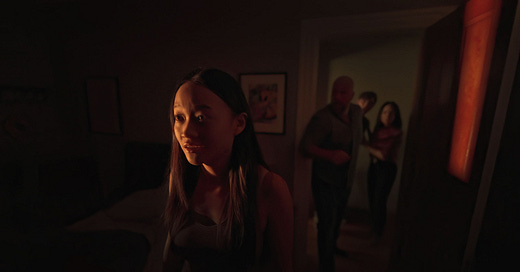I have a friend who doesn’t think ghosts are particularly scary. Not because she doesn’t believe in them but because they represent the demands of justice. They have unfinished business here on earth, and they’ve stuck around to see it through. I like this theory. There’s something comforting about knowing that justice isn’t confined to a single lifespan, that there’s still a chance for change even after someone has taken their last breath. It recognizes that we’re not alone on this planet and our actions reverberate even after we’re gone. Death becomes a little less scary, something like a second chance to make things right.
Presence is a ghost story, though not a particularly scary one. This is intentional. It’s shot entirely in first-person from the perspective of the ghost, bringing us literally and figuratively into the ghost’s head. (This approach brings to mind Nickel Boys, another recent release that uses a similar first-person camera, albeit with a completely different tone and mood.) We see what the ghost sees as it blinks in and out of existence within a single house: first empty, then occupied by a family. We get the sense that the ghost means no harm, that it’s curious about the people who occupy its space, that it might not necessarily know who it had been in life.
The ghost’s feeling of detached curiosity permeates the movie. Presence is a filmmaking exercise by director Steven Soderbergh, who likes to push the boundaries of filmmaking by experimenting with the ways technology can be used to tell a story. This particular exercise is about using perspective to shape the audience’s perception of a story that would otherwise be a straightforward, even boilerplate, horror story. Flip the perspective to the ghost’s point of view, and the story becomes a mystery instead.
The family who occupies the house is small: a couple named Chris (Chris Sullivan) and Rebecca (Lucy Liu) and their two teenage children, Chloe (Callina Liang) and Tyler (Eddie Maday). From the start, it’s clear that Chloe isn’t doing well; a close friend of hers has died recently, and she’s struggling to cope. Tyler is more well-adjusted, at least in his mother’s eyes; he’s a popular jock, dismissive of his sister’s emotional troubles. He takes after his mother, who is driven and ruthless; Rebecca in turn enjoys his stories about his exploits with his peers at school, while Chris and Chloe—the gentler half of the family—take solace in each others’ quiet discontent. The family is messed up and quietly desperate, though no one feels like talking about it much. They are haunted by the better versions of themselves that they could be, to varying degrees of guilt.
The loosely knit family drama is most interesting when Soderbergh experiments with the camera, drawing out details that can’t be communicated via dialogue. He uses a wider-than-usual lens on a very small camera, allowing him to back into closets and tight corners. The close-ups lend the story a sense of intimacy, while the wide lens provides the sense that the ghost can see more than other people, that it has a slightly fuller understanding about what’s going on. Still, the ghost has its own limitations, ascending and descending the stairs the same way a living person might. It’s a result of the camera being operated by an actual human, and perhaps also an indication that even ghosts are creatures of habit. The creative choice calls attention to the intentions behind the camera that drive the story. Some viewers might find it distracting, while others may treat it as a call to pay attention to the camera-as-character, to remember that they are not passive participants in the story.
The film, set in a single house—which the ghost can’t leave—isn’t just a formal exercise. It’s also a moral one, questioning notions of justice and fairness within the small confines of a messed-up family. At its best, the experimental form marries function. In one striking shot, the family gathers on the back porch after they realize there is something spooky in the house. The ghost stands near the back door, gazing out through a window, while Chris stands on the other side of the glass, concern on his face as he peers back in. The glass barrier between them is invisible but still very real: a window between worlds that can’t be breached but can be looked through.
The scale of the drama, with its parameters neatly confined to the inside of the house, means that the movie opens and closes with all loose threads carefully tied off and tucked away. The formal exercise is beautifully contained. The moral exercise is self-contained, too, but in a way that works best when taken only on its own terms. Questioning the boundaries of the experiment opens up the viewer to questioning the movie itself; it’s best treated as a thought experiment rather than a complex world. Ultimately, this is an optimistic film: justice will be done, in this life or the next, in the right place at the right time. The real world is messier, but the real world is a lot less fun to think about.—Sarah Welch-Larson
★★★☆
Presence is in theaters now.





